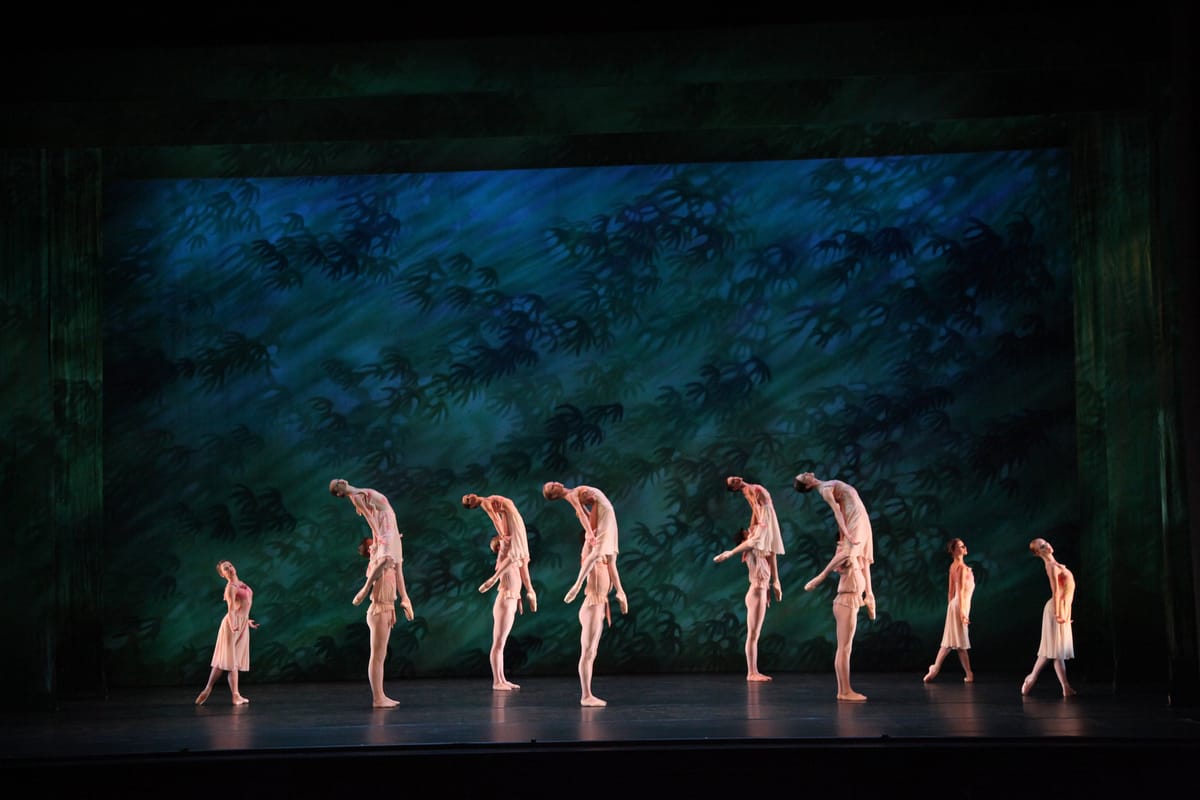Champagne and Sweat

“Ballo della Regina”, “The Leaves are Fading”, “From Here on Out”
American Ballet Theatre
City Center
New York, NY
October 26, 2007
Effervescent, frivolous charm is a rare commodity in any art, and the most successful attempts tend to be underrated, since part of their success is the lighthearted ease they must present. Balanchine’s "Ballo della Regina" is usually viewed as a female dancer’s technical tour de force, which of course it is. But it is also choreographic champagne, made from delicious music and bubbling little surprises. Gillian Murphy, though she doesn’t quite have the fearless daredevil attack that Merrill Ashley did, negotiated the challenges, and most of the slight fuzziness seen at the gala was gone. But the pure joy remained. David Hallberg proved once again that he has one of the cleanest jumps on record. Some I spoke to were a little taken aback by his un-NYCB approach, but for me, the hints that the steps might actually mean something, that the man was seeking someone and was genuinely happy when he found her is a logical development of the choreography and of the hint of a story (Verdi’s music was set to a libretto of a man looking for a pearl in the ocean). It certainly seems that Balanchine knew the libretto, since he had his corps move with delicate underwater tints; it is a fine acquisition for ABT, and would look even better on the Met stage.
Antony Tudor’s The Leaves are Fading is, apparently, Tudor’s take on the 1970-style folk-inflected group nostalgia ballets, so memorably exemplified by Robbins’ Dances at a Gathering—despite the pink and green décor, the feel is definitely autumnal. Tudor, though, gave his work his own unique drama, and in spite of the anonymous couples, the dances have distinct characteristics.
It is undeniably a memory piece—the opening and closing woman in green (Jennifer Alexander, who has the timeless beauty of a medieval Madonna, but who could have been a bit less aware of the audience) sets the tone. The various dancers come and go with a seeming lack of structure, and the four pas de deux do not trace a logical, chronological development; the magical effect is like being in someone’s mind and seeing, feeling and almost hearing random pieces of memory. No one, except in movie flashbacks, remembers events coherently.
The memories are of the various stages of love, from frivolous youth (the first pas des deux, danced by Yuriko Kajiya and Aaron Scott to serenity (the third pas deux, danced by Melissa Thomas and Roman Zhurbin), with detours for passionate drama (the fourth pas de deux, Veronika Part and Cory Stearns). The heart of the ballet is the second couple, Xiomara Reyes and Gennadi Saveliev. They appear unnoticed, slipping into a larger group dance, a subtle Tudor moment of pure genius; memories don’t usually announce themselves for the audience to applaud.
Reyes gave the long pas de deux an interesting shading and variety; she was somewhat hesitant at first, happy, but a little cautious, until the trust had been built. Several years ago I interviewed Amanda McKerrow (who with her husband John Gardner staged this revival), and she talked about Tudor’s feelings about this dance. “I was originally down to do the first pas de deux, but Mr. Tudor asked me to do the second one, the lead, and he taught it to me. He didn’t want the ballet to be sentimental, he really stressed that. He also said that the second pas de deux was a couple who were still fairly early in their relationship, when things were still exciting and fun, but getting more serious. The woman is looking off in the distance, thinking of the home they are going to have together, and maybe a child or two, and a dog, and it’s all going to be so beautiful. Then the man reminds her that he is still there, and she comes back to the present, but she keeps leaving the moment to think about the future, a very feminine thing to do!—and the man keeps bringing her back to the now. There’s a level of trust in that one that isn’t there in the first and fourth ones.” Reyes, though she doesn’t really have the singing lyrical line of some of the more romantic interpreters, caught the dynamic of the emotions very well, helped immeasurably by Saveliev, who gave a grounded, gentle, and committed performance.
The evening closed with the premiere of Benjamin Millepied’s From Here on Out, a purposefully ambiguous title (to be polite, though meaningless might be a more accurate term) to some energetic film-score type music by Nico Muhly, long on atmosphere but short of actual danceable rhythm. The atmosphere was the now-standard dark groupings in harsh lighting, but the gold background and the flattering dark purple leotards (designed by Millepied) gave the opening an intriguingly ominous feel.
Unfortunately, this did not develop into much. The group left, and various couples reformed, all, apparently given the directions “Enter stage left, pretend to be a hyperactive snake regurgitating a pretzel, and exit stage right”. The lead couple, Paloma Herrera and Marcelo Gomes, were also given these same instructions, but told to do it in slow motion while making faces at each other. This is yet another piece where the dancers work hard (and look very good while doing it) but to little real emotional effect—it is all about sweating, where real art is in the bubbles.
Copyright 2007 by Mary Cargill



